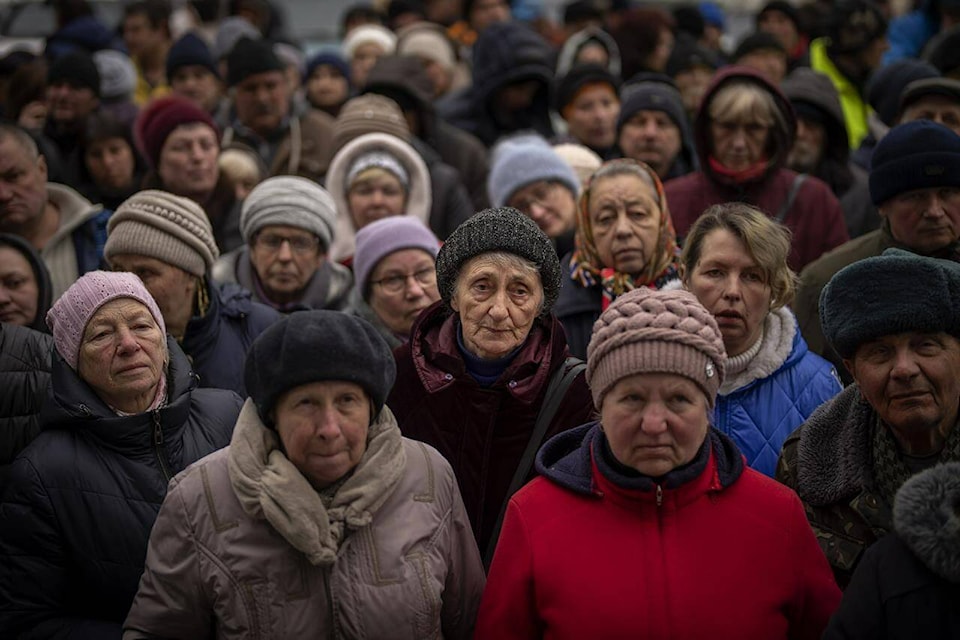Russia ratcheted up its battle for control of Ukraine’s eastern industrial heartland Tuesday, assaulting cities and towns along a boomerang-shaped front hundreds of miles long in what both sides described as a new phase of the war.
After a Russian push to overrun the capital failed, the Kremlin declared that its main goal was the capture of the mostly Russian-speaking eastern Donbas region, where Moscow-backed separatists have been fighting Ukrainian forces for eight years.
If successful, that offensive would give President Vladimir Putin a vital piece of Ukraine and a badly needed victory in the now 7-week-old war that he could present to the Russian people amid mounting casualties and economic hardship caused by the West’s sanctions.
It would also effectively slice Ukraine in two and deprive it of the main industrial assets concentrated in the east, including coal mines, metals plants and machine-building factories.
Ukraine’s military said early Tuesday that a “new phase of war” began a day earlier when “the occupiers made an attempt to break through our defenses along nearly the entire front line.” Russian Foreign Minister Sergey Lavrov said that “another phase of this operation is starting now.”
Ukrainian President Volodymyr Zelenskyy said that massive numbers of Russian troops were committed to the campaign, though some observers noted that an escalation has been underway there for some time and questioned whether this was truly the start of new offensive.
Justin Crump, a former British tank commander now with the strategic advisory company Sibylline, said the Ukrainian comments could, in part, be an attempt to persuade allies to send more weapons.
“What they’re trying to do by positioning this, I think, is … focus people’s minds and effort by saying, ‘Look, the conflict has begun in the Donbas,’” Crump said. “That partly puts pressure on NATO and EU suppliers to say, ‘Guys, we’re starting to fight now. We need this now.’”
European and American arms have been key to bolstering Ukraine’s defense, helping the under-gunned country to hold off the Russians. Dutch Prime Minister Mark Rutte told Zelenskyy on Tuesday that the Netherlands would send “heavier material,” including armored vehicles.
In what appeared to be an intensification of attacks, Russian Defense Ministry spokesman Maj. Gen. Igor Konashenkov said that air-launched missiles destroyed 13 Ukrainian troop and weapons locations, while the air force struck 60 other Ukrainian military facilities, including missile warhead storage depots.
Russian artillery hit 1,260 Ukrainian military facilities and 1,214 troops concentrations over the last 24 hours, Konashenkov said Tuesday. The claims could not be independently verified.
The assaults began Monday along a front that stretches more than 300 miles (480 kilometers) from northeastern Ukraine to the country’s southeast.
Russia said it struck several areas with missiles, including the northeastern city of Kharkiv as well as as areas around Zaporizhzhia and Dnipro west of the Donbas.
Associated Press journalists in Kharkiv said at least four people were killed and three wounded in a Russian attack on a residential area of the city, which is near the front lines and has faced repeated shelling. The attack occurred as residents attempted Tuesday to maintain a sense of normalcy, with municipal workers planting spring flowers in public areas.
An explosion also rocked the eastern city of Kramatorsk on Tuesday, killing at least one person and wounding three, according to AP journalists at the scene.
Eyewitness accounts and reports from officials have given a broad picture of the extent of the Russian advance. But independent reporting in the parts of the Donbas held by Russian forces and separatists is severely limited, making it difficult to know what is happening in many places on the ground.
Moscow’s troops seized control of one town in the Donbas on Monday, according to Luhansk Gov. Serhiy Haidai. Oleksiy Danilov, secretary of Ukraine’s national security council, said that the defensive line had held elsewhere.
The breakthrough in Kreminna takes the Russians one small step closer to their apparent goal of encircling Ukrainian troops in the region.
Retired British Gen. Richard Barrons told the BBC that “in this particular battle the Russians will be approaching the Ukrainians from the east, but also from the north and the south to try and get behind them, and so this is a more complex military problem for the Ukrainians.”
Key to the campaign to take the east is the capture of Mariupol, the port city in the Donbas that the Russians have besieged since the early days of the war.
Shelling continued there, and Russia issued a new ultimatum Tuesday to the Ukrainian defenders holed up there to surrender, saying those who come out will “keep their lives.” The Ukrainians have ignored previous such offers.
The Kremlin-backed leader of Chechnya, Ramzan Kadyrov, whose forces have taken part in the fighting in Mariupol, said on a messaging app that Russian forces would root out the Ukrainian resistance within hours and take full control of the steel mill on Tuesday. Kadyrov is known for his bluster and has repeatedly predicted the city’s fall in the past.
Securing Mariupol would free Russian troops up to move elsewhere in the Donbas, deprive Ukraine of a vital port, and complete a land bridge between Russia and the Crimean Peninsula, seized from Ukraine from 2014.
—Adam Schreck, The Associated Press
RELATED: Russia renews strikes on Ukraine capital, hits other cities
